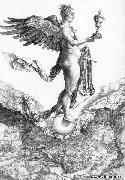Wholesale Oil Painting No Minimum |
|||||||||||
|
|
|||||||||||

|
|||||||||||
|
|
|
||||||||
Albrecht Durerb.May 21, 1471, Imperial Free City of Nernberg [Germany] d.April 6, 1528, Nernberg Albrecht Durer (May 21, 1471 ?C April 6, 1528) was a German painter, printmaker and theorist from Nuremberg. His still-famous works include the Apocalypse woodcuts, Knight, Death, and the Devil (1513), Saint Jerome in his Study (1514) and Melencolia I (1514), which has been the subject of extensive analysis and interpretation. His watercolours mark him as one of the first European landscape artists, while his ambitious woodcuts revolutionized the potential of that medium. D??rer introduction of classical motifs into Northern art, through his knowledge of Italian artists and German humanists, have secured his reputation as one of the most important figures of the Northern Renaissance. This is reinforced by his theoretical treatise which involve principles of mathematics, perspective and ideal proportions. His prints established his reputation across Europe when he was still in his twenties, and he has been conventionally regarded as the greatest artist of the Renaissance in Northern Europe ever since. |
||||||||
|
|
||||||||
Nemesis or Good Fortune
Nemesis or Good Fortune Painting ID:: 63580 |
1502 Engraving, 332 x 232 mm Staatliche Kunsthalle, Karlsruhe This engraving was created between 1501 and 1503 and was one of D?rer's main large format engravings. The female figure is derived from the poem Manto by the Italian poet and humanist Poliziano, which D?rer presumably became acquainted with when studying in the library of his humanist friend, Willibald Pirckheimer. The poem combines the goddesses of Revenge and Fate. The female shape is floating along above the clouds on a globe and with eagle wings, holding a goblet in her right hand and bridle in her left. She is the result of D?rer's studies of Vitruvius' proportions. Copies of this print were frequently given as presents by D?rer during his trip to the Netherlands during 1520-21. Vasari describes it as "a nude figure floating in the clouds, representing Temperance, with magnificent wings, a golden cup and reins in her hands." The reins signify restraint from temptation that should be exercised by man; the sphere uncertainty. The figure is proportioned according to the canon of Vitruvius. The landscape below has been identified as the village of Klausen (Chiusa) in the Valle d'Isarco in the Tyrol, which lay on D?rer's route of travel to Venice.Artist:D?RER, Albrecht Title: Nemesis or Good Fortune Painted in 1501-1550 , German - - graphics : mythological 1502 Engraving, 332 x 232 mm Staatliche Kunsthalle, Karlsruhe This engraving was created between 1501 and 1503 and was one of D?rer's main large format engravings. The female figure is derived from the poem Manto by the Italian poet and humanist Poliziano, which D?rer presumably became acquainted with when studying in the library of his humanist friend, Willibald Pirckheimer. The poem combines the goddesses of Revenge and Fate. The female shape is floating along above the clouds on a globe and with eagle wings, holding a goblet in her right hand and bridle in her left. She is the result of D?rer's studies of Vitruvius' proportions. Copies of this print were frequently given as presents by D?rer during his trip to the Netherlands during 1520-21. Vasari describes it as "a nude figure floating in the clouds, representing Temperance, with magnificent wings, a golden cup and reins in her hands." The reins signify restraint from temptation that should be exercised by man; the sphere uncertainty. The figure is proportioned according to the canon of Vitruvius. The landscape below has been identified as the village of Klausen (Chiusa) in the Valle d'Isarco in the Tyrol, which lay on D?rer's route of travel to Venice.Artist:D?RER, Albrecht Title: Nemesis or Good Fortune Painted in 1501-1550 , German - - graphics : mythological |
|||||||
|
CONTACT US |

